TechRadar Verdict
Unlimited power for a nigh-unlimited price, the Acer Predator Orion 9000 delivers the best performance from a gaming PC we seen, but it’s a machine few can afford and an even smaller subset of users will need.
Pros
- +
Most performant gaming PC we’ve reviewed
- +
Mostly tool-less upgradability
- +
Sharp, bold styling
Cons
- -
Extra-dimensional price
- -
Can’t max out Nvidia G-Sync HDR monitor
- -
Loaded with bloatware
Why you can trust TechRadar
The Acer Predator Orion 9000 is by far the most over the top gaming desktop we’ve ever reviewed. It’s easily the most over the top PC in the world, too, through its sheer size and insane parts inside, like an 18-core Intel Core i9 processor, dual Nvidia GTX 1080 Ti’s and a whopping 128GB of RAM.
Unfortunately, this gaming PC comes with an egregious price, which will make it accessible to a select few. Then, there’s honestly an even smaller group of people who will need this much power.
But, at the very least, for that incredibly tiny subset of users, they’ll come to be amazed by how performant this ultimate gaming PC is, and it’s a clear sign that Acer’s PC building chops have improved greatly.
Here is the Acer Predator Orion 9000 configuration sent to TechRadar for review:
CPU: 2.6GHz Intel Core i9-7980XE (octadeca-core, 4.2GHz with turbo boost)
Graphics: 2 x Nvidia GeForce GTX 1080 Ti (11GB GDDR5X VRAM; SLI)
RAM: 128GB (DDR4 2,666MHz)
Motherboard: TK
Power Supply: 1,000W modular power supply
Storage: 512GB SSD (NVMe M.2); 2TB HDD (7,200 rpm)
Optical drive: 16X DVD-RW Drive
Ports (front): 3 x USB 3.1 Gen 1 Type-A, 1 x USB 3.1 Gen 1 Type-C, headphone jack, microphone jack
Ports (rear): 4 x USB 3.1 Gen 1 Type-A, 1 x USB 3.1 Gen 2 Type-C, 1 x USB 3.1 Gen 2 Type-A, 2 x USB 2.0, 6 x DisplayPort, 2 x HDMI 2.0, optical out, 6 x audio jacks, Ethernet
Connectivity: Intel AC 8265 802.11ac, Bluetooth 4.2
Operating system: Windows 10 Home
Weight: 42.33 pounds (19.2kg)
Size: 11.8 x 27.6 x 25.3 inches (30 x 70 x 64.3cm; W x D x H)
Pricing and availability
After reviewing the $4,311 (about £3,050, AU$5,440) Origin Millennium and $4,129 (about £3,175, AU$5,225) Alienware Area 51, we didn’t think there could be a more expensive gaming PC. But, lo and behold, the price of our review unit here is $7,999 (£7,186, AU$10,583).
We’re not going to go into the whole “this PC costs more than a down payment on your car” rhetoric again. At this point, what couldn’t you buy for $8,000?
Unfortunately for the Orion 9000, there are more affordable machines that you can spec up to meet this insane spec sheet. An Alienware Area 51 equipped with the same processor and dual GPUs rings up for $6,599 (£6,119, AU$10,471) if you option only 64GB of memory. Meanwhile, we configured the Origin Millennium to the same specs on the right for a grand total of $7,956 (about £6,110, AU$10,798) – so marginally more affordable.
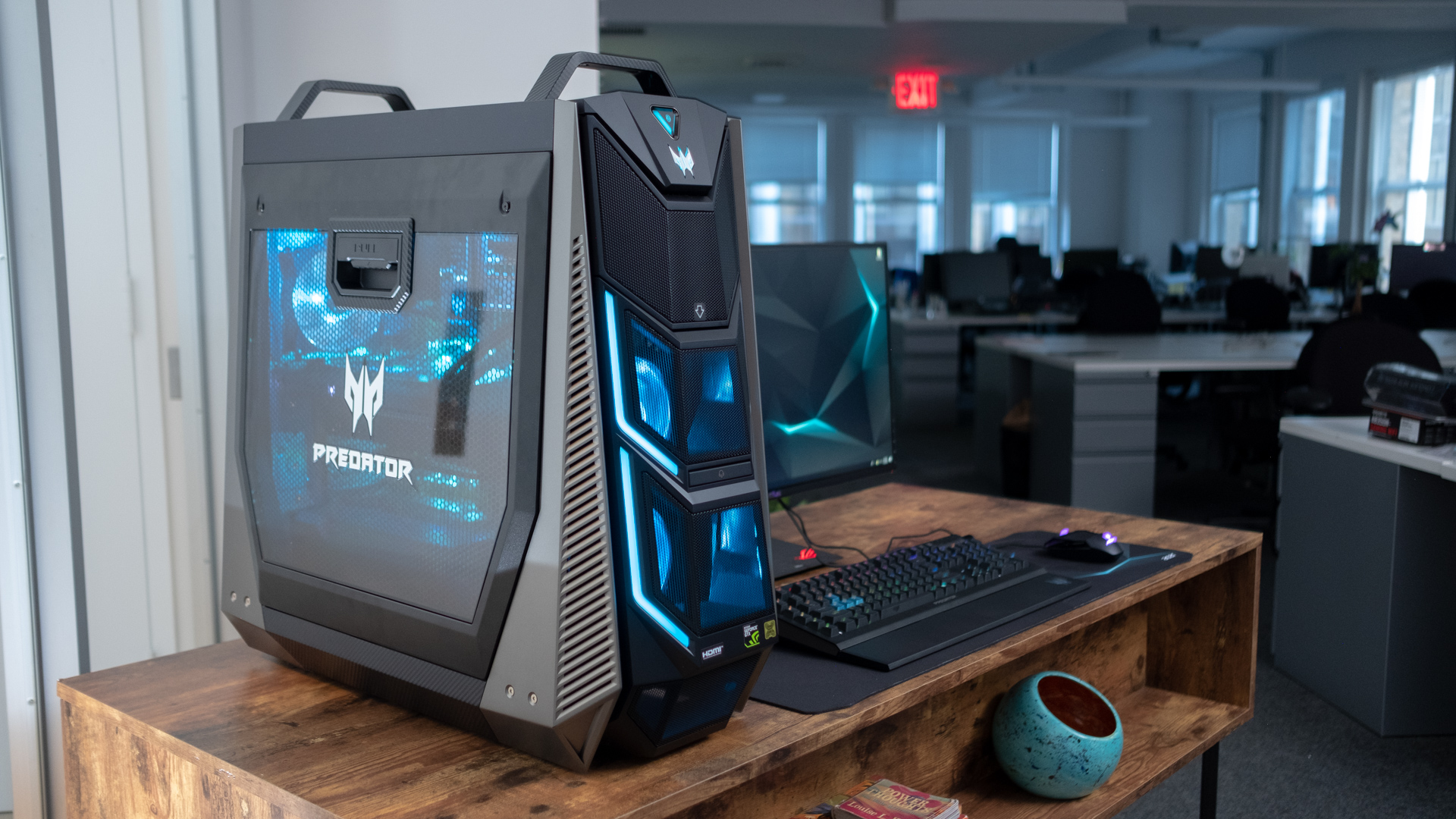
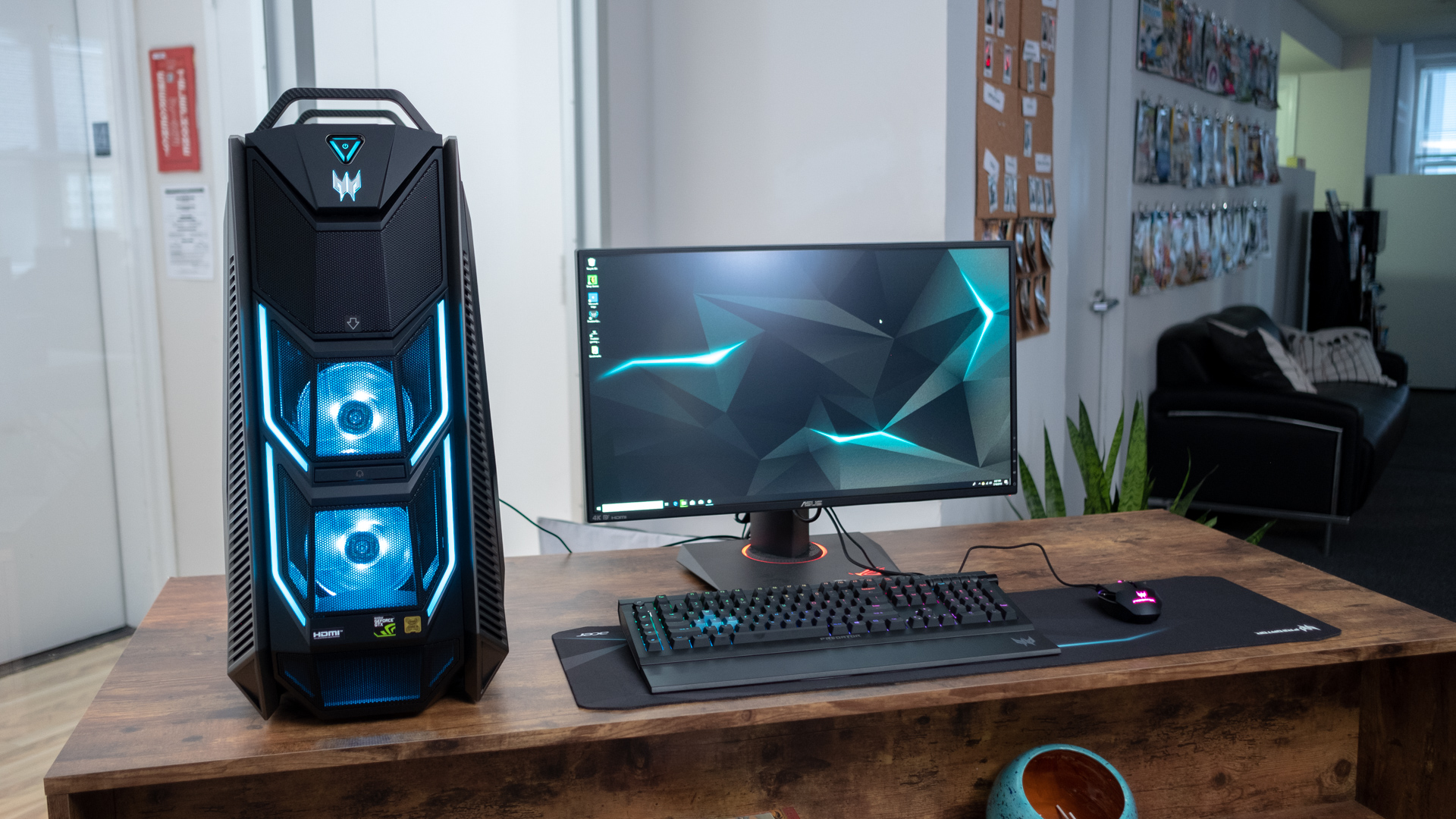
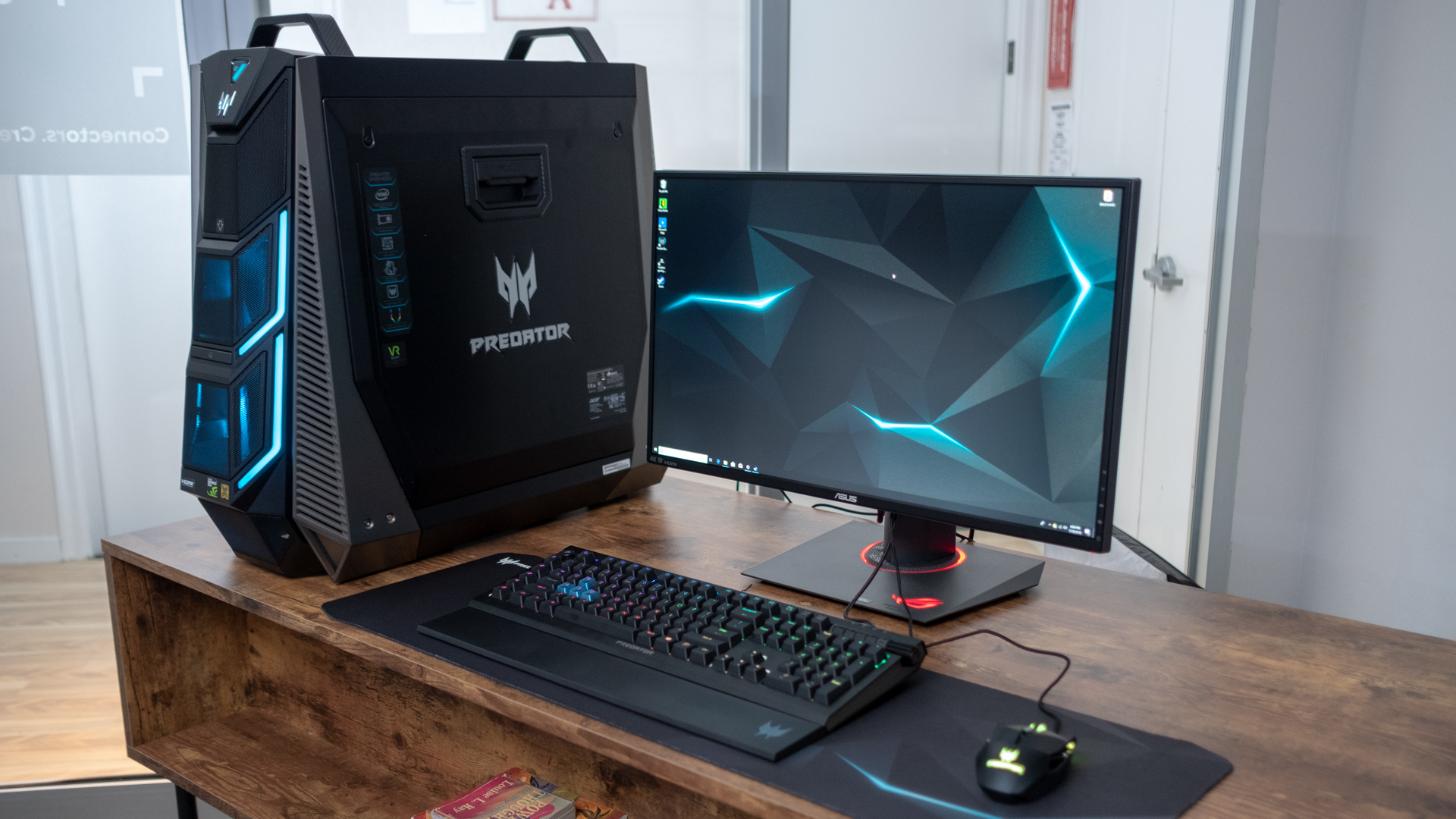
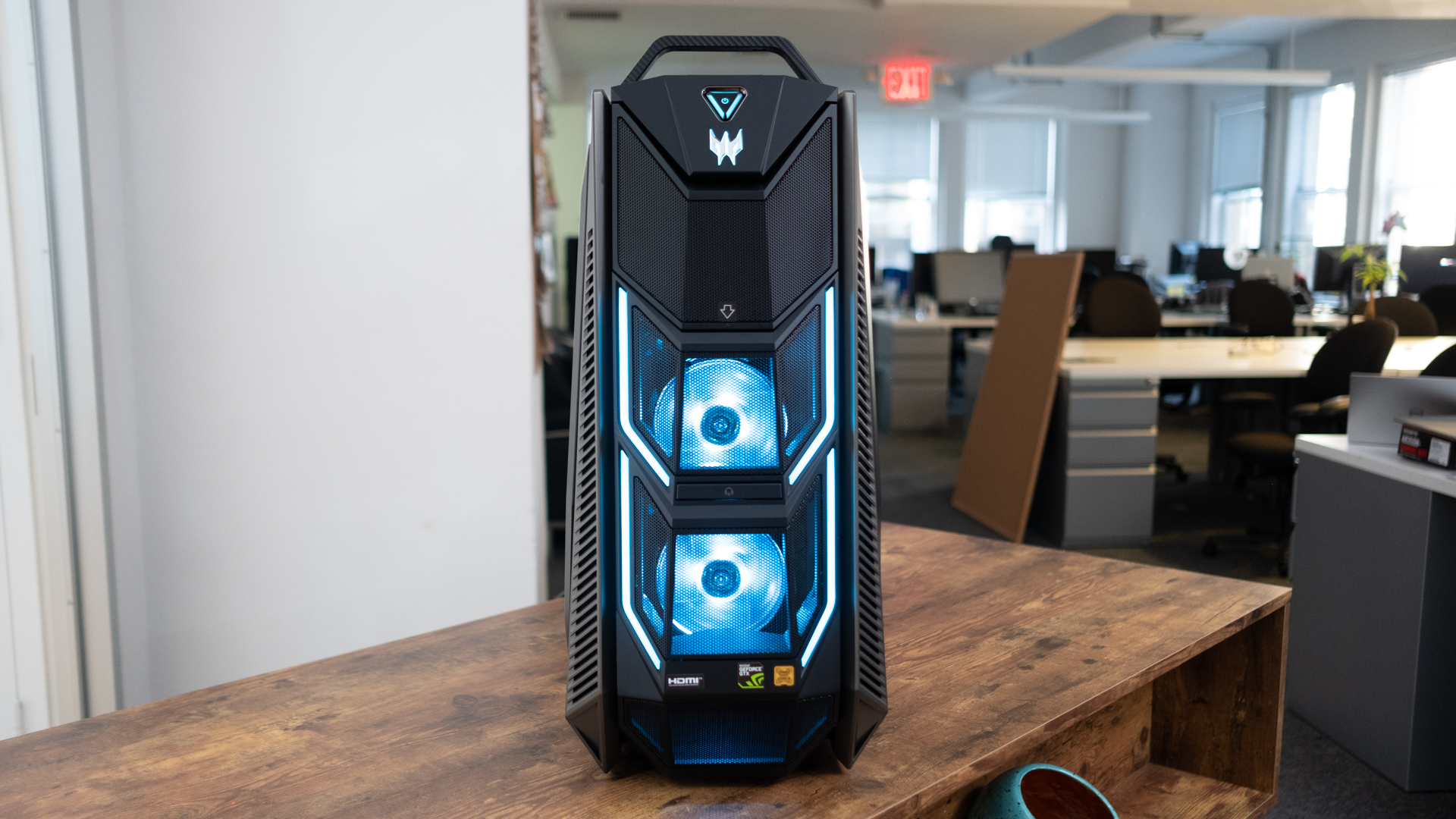

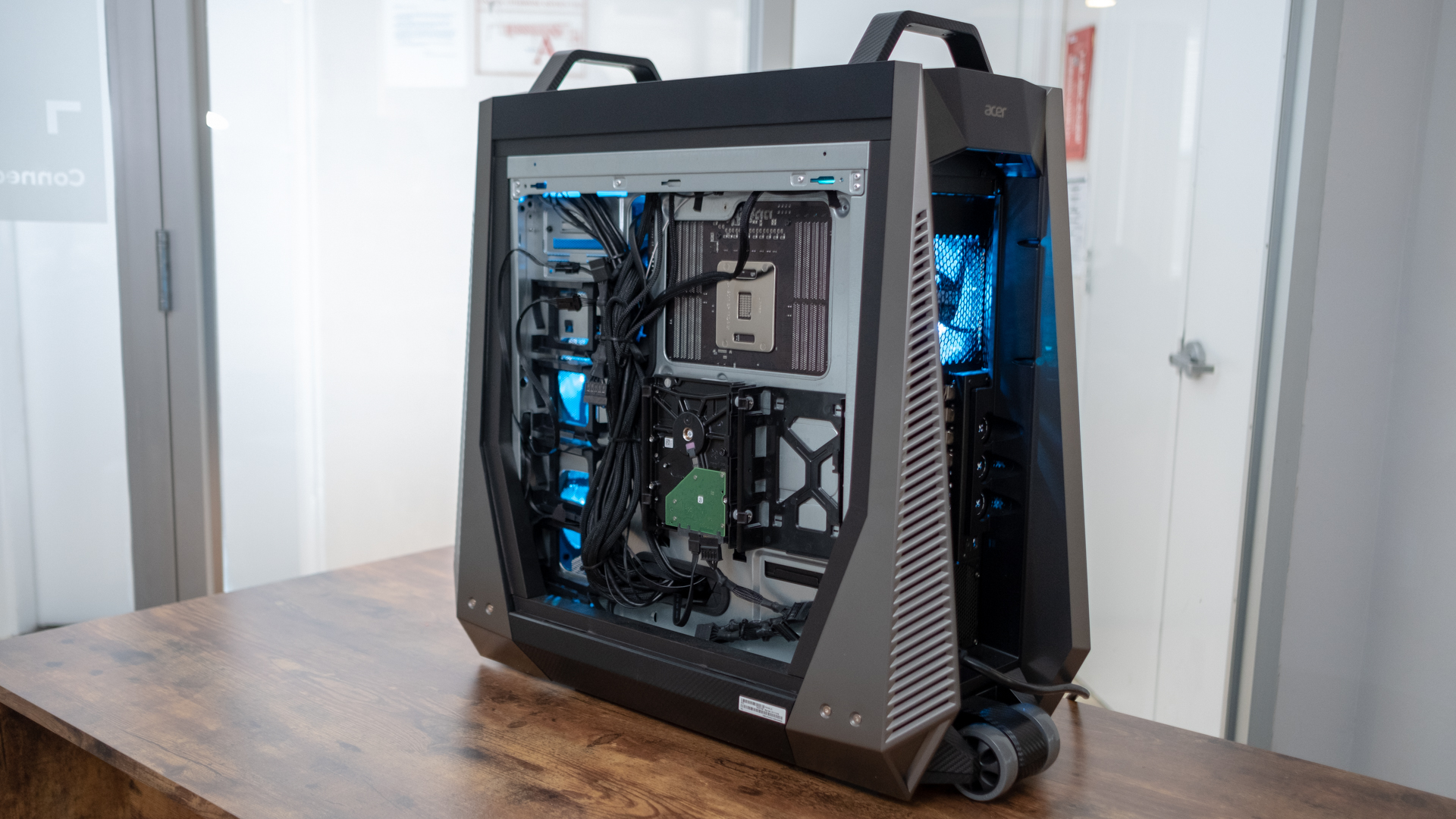

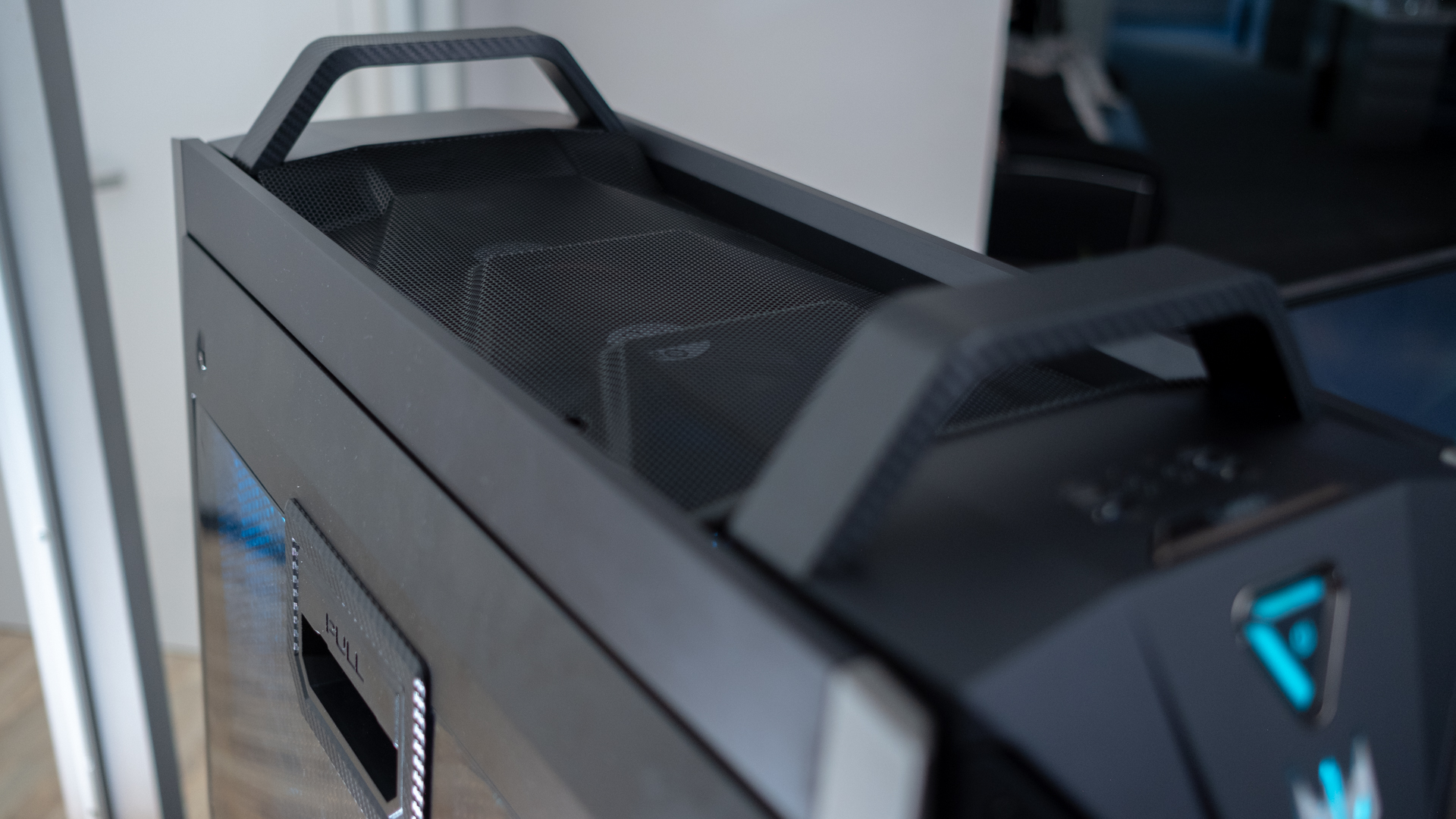

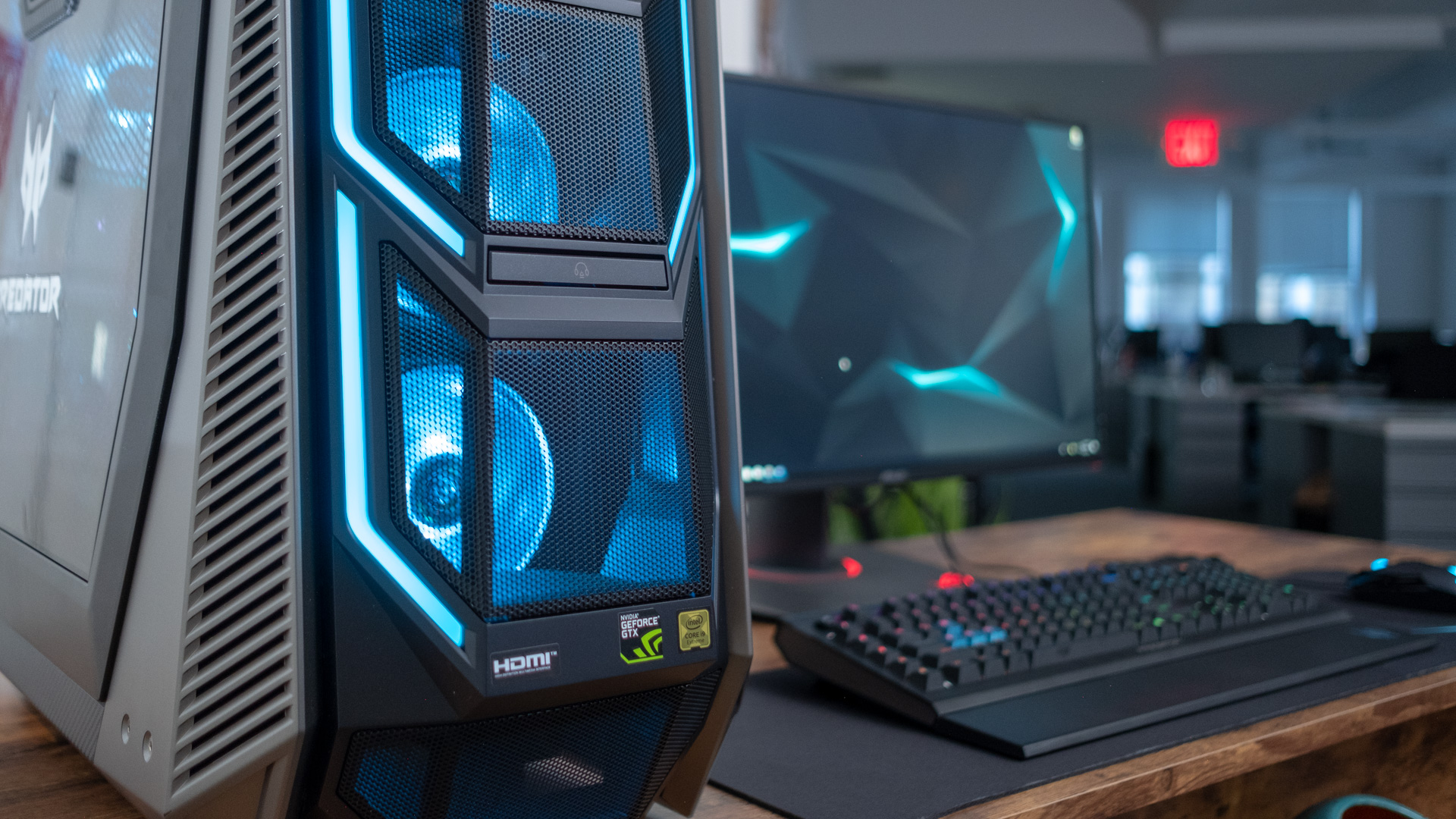
Design
The Acer Predator Orion 9000 is a big step up in both size and aesthetics from the design of Predator G6 and G9 that preceded it. Standing in at 11.8 x 27.6 x 25.3 inches (30 x 70 x 64.3cm; W x D x H) with a starting weight of 42.33 pounds (19.2kg), this is a monolith of a gaming desktop.
A distinctly trapezoidal shape and sheer size make this PC look like a Stargate chevron that fell off its ring. At the same time, it also reminds us a little of the Tyrell building in the original Blade Runner movie. Considering the majority of the Predator gaming-related promotional materials revolves around space, we’d say that Acer successfully evokes the sci-fi motif it was aiming to achieve with this gaming desktop.
Thankfully, the Orion 9000 moves away from the space tire look that the Predator G6 featured for a simpler stack of three, large metal grilles jutting out the front of the case in sequential order. You’ll also find some strips of Acer’s now signature blue lighting traced around the gaming PC’s front panels.
Of course, it wouldn’t be an Acer gaming desktop without hidden compartments, as flipping down the top-most panel reveals a stealth disc tray. Meanwhile, pushing in the button between the second and bottom-most grilles also releases a retractable stand for you to hang a gaming headset from.
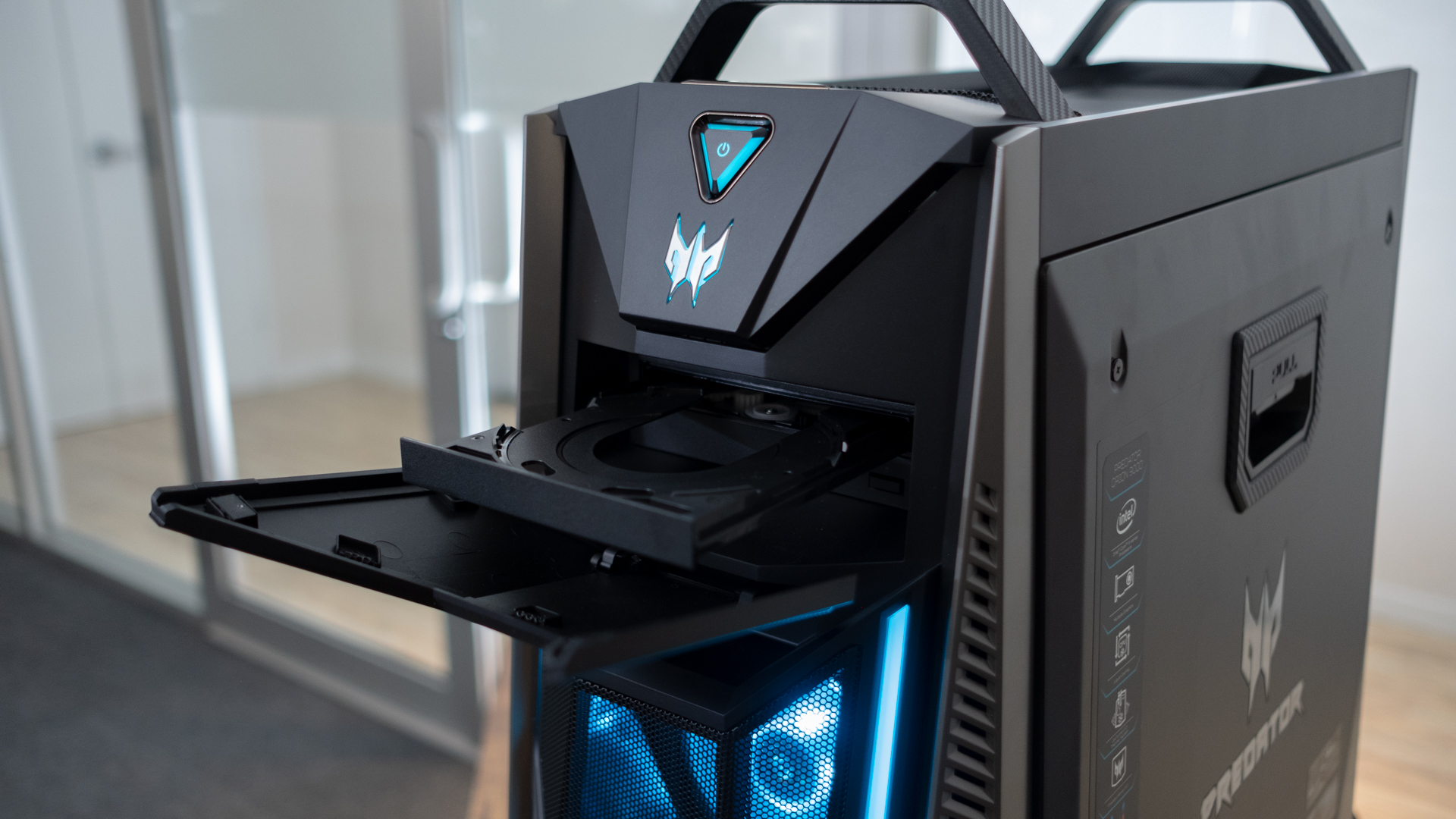
Above all this, near or along the top of the chassis, you’ll find the Nabla-shaped power button and a convenient Turbo button that will automatically overclock the processor. There’s also the usual set of headphone/microphone jacks, USB 3.0 ports and a USB-C port – but no front-side HDMI to support virtual reality headsets.
Around the back, you’ll find a rear wheel and even handles along the top of the chassis designed to help you tote it around. It works well enough when you pitch the PC back a little and drag it along by its front angle, but because the PC weighs about 50 pounds, don’t expect to go very far before you tire out. Rather, the dolly system comes more in handy for roughly positioning the PC into place, where it’ll likely sit forever.
You also get a clear acrylic window – sorry, no tempered glass here – built into the left panel. Pulling off either of the side panels makes you feel as if you’ve just taken off an access panel on a spaceship as they both feature an nontraditional, five-sided shape, metal build and feature a center-positioned handle with integrated button release.
That said, we wished the window was a little bigger considering how large the main chassis is and a good bit of the clear material is covered up by Acer’s rather large logo printed in the center.
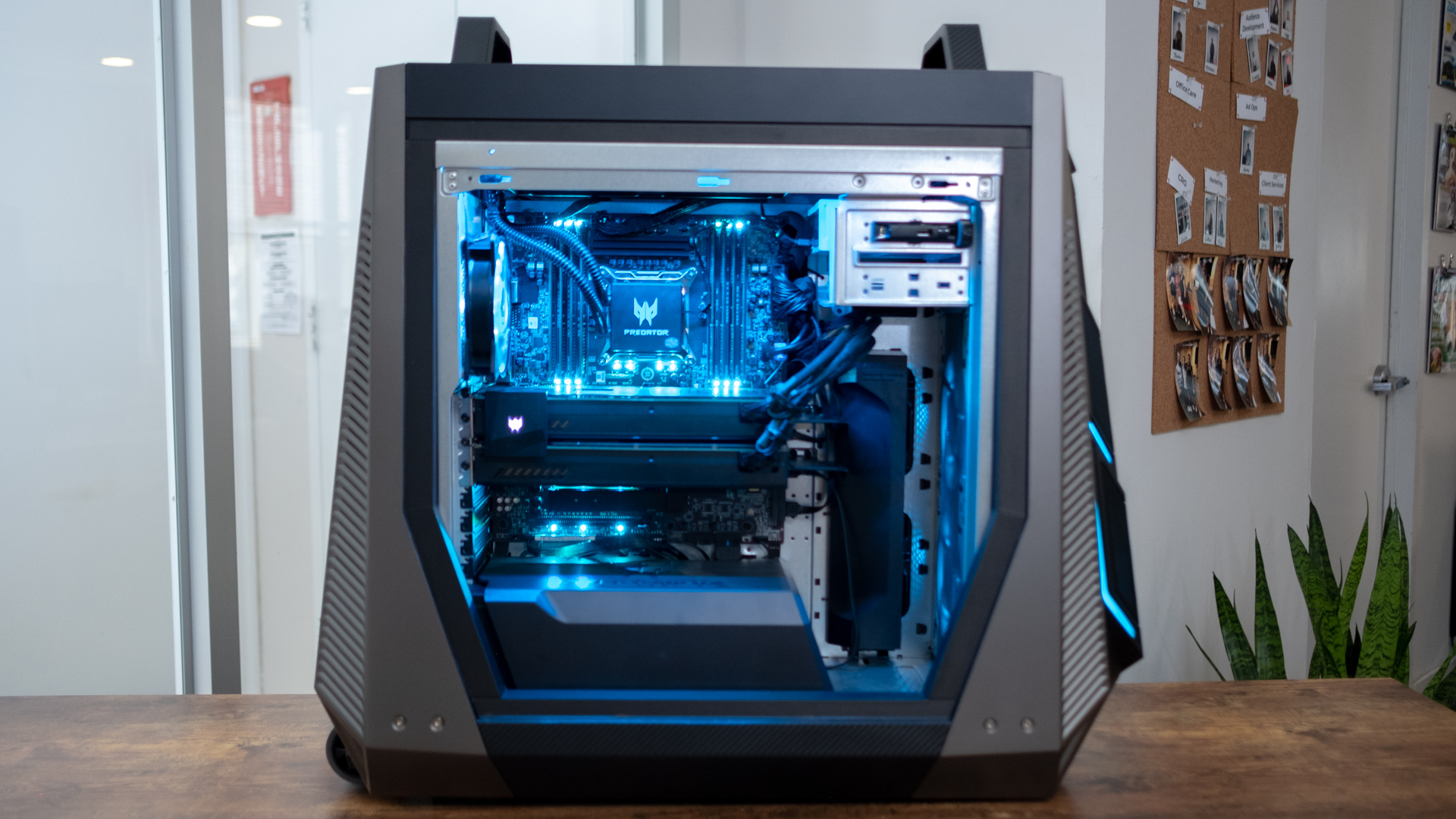

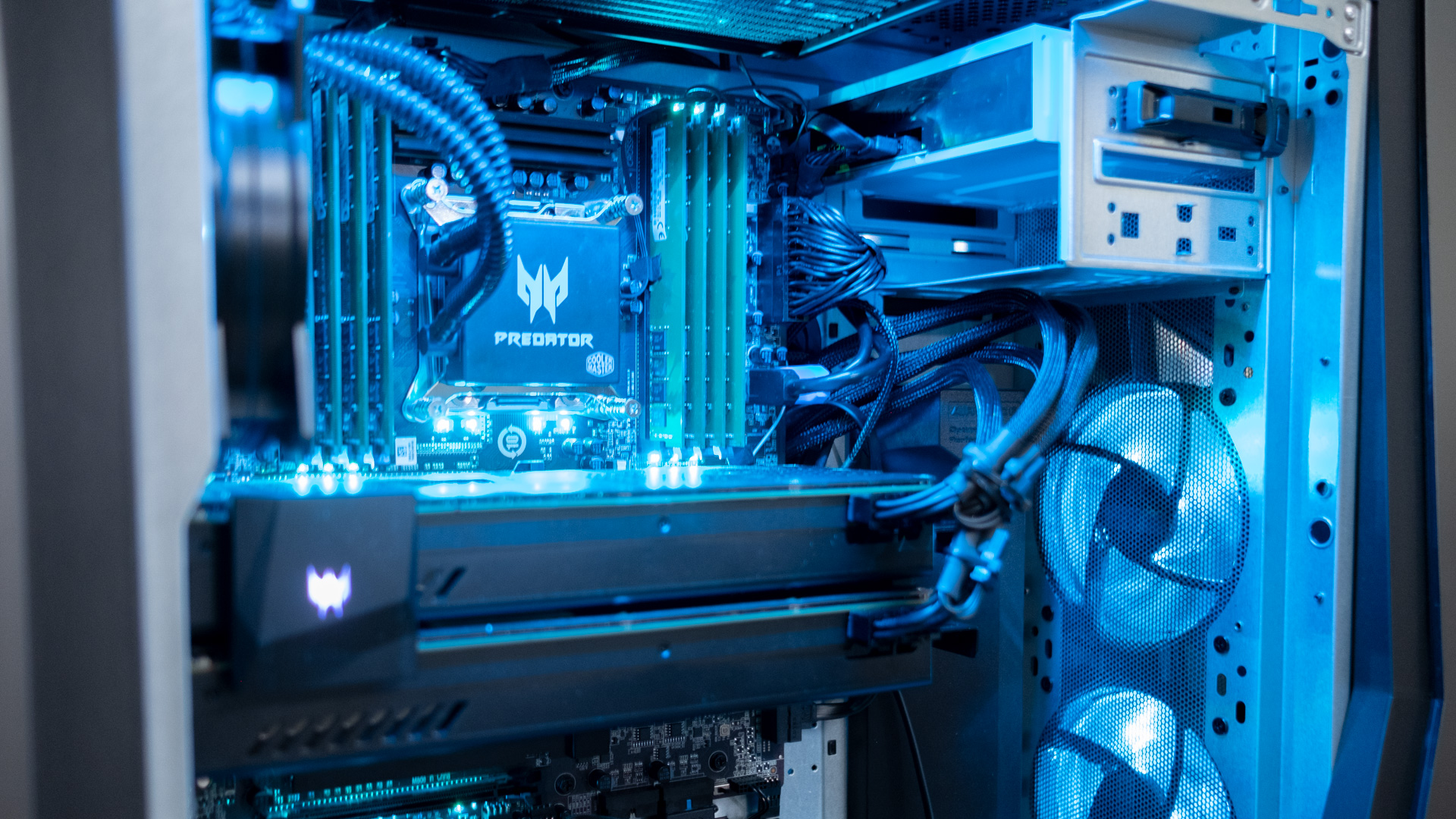
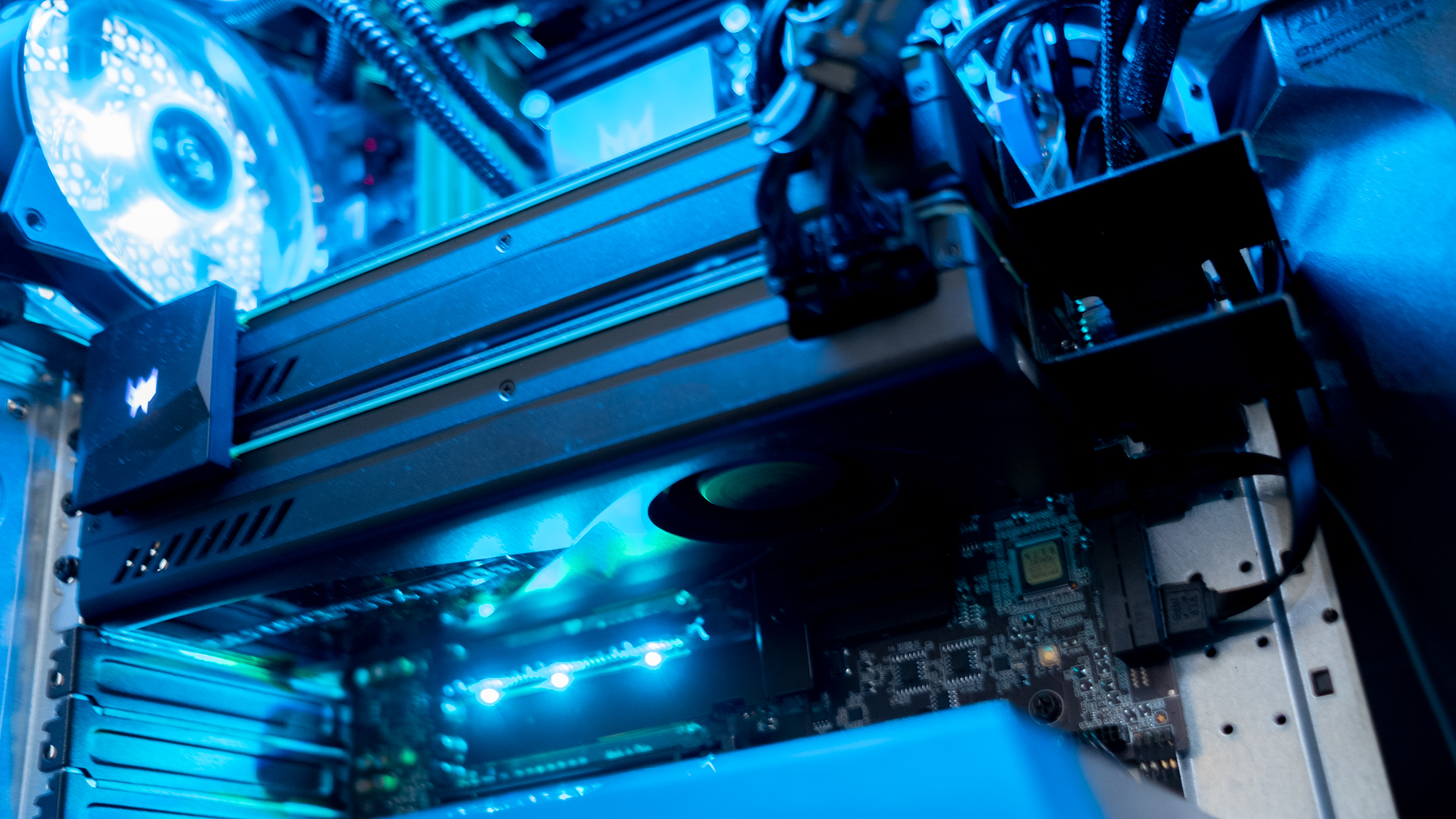
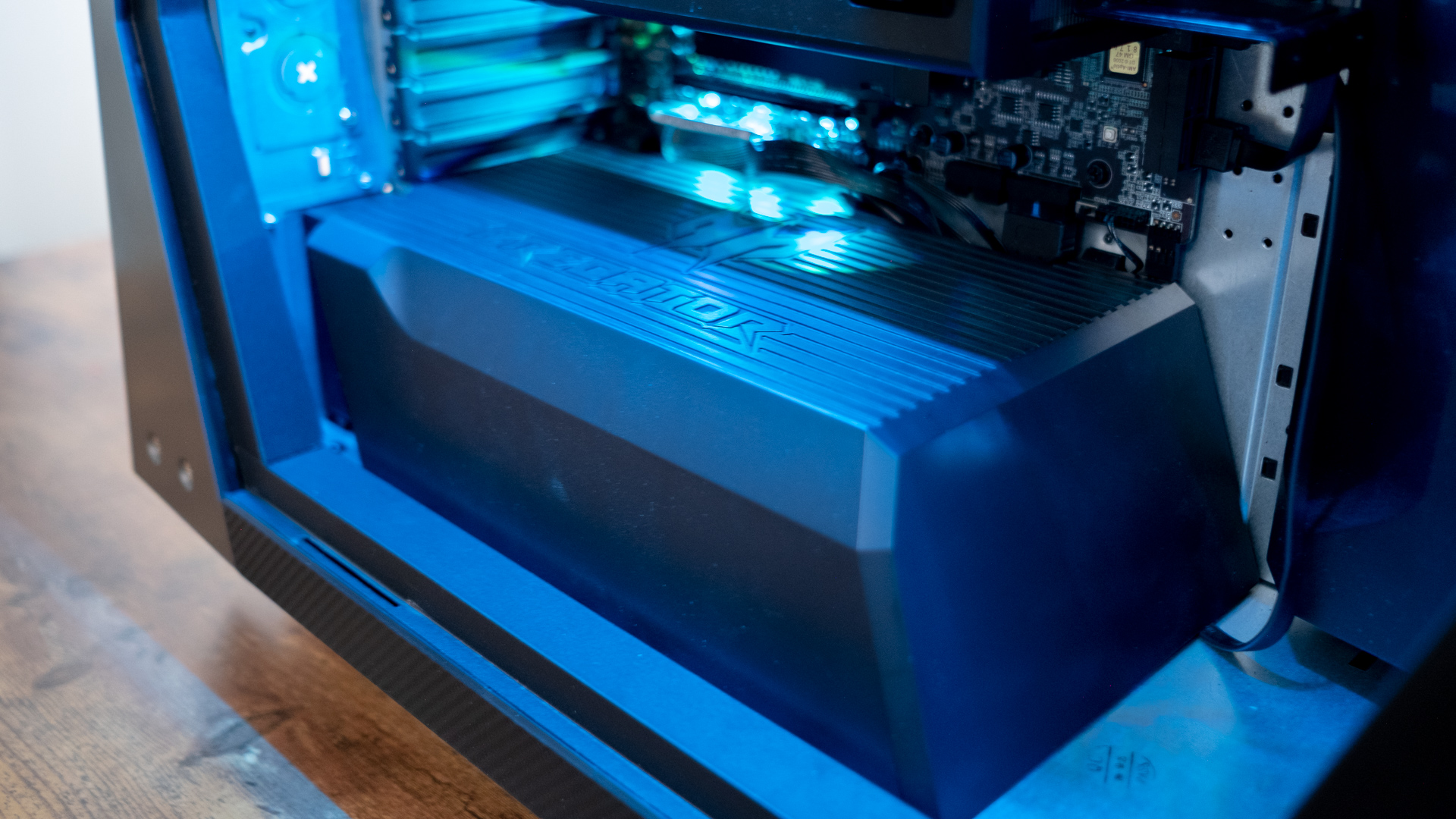
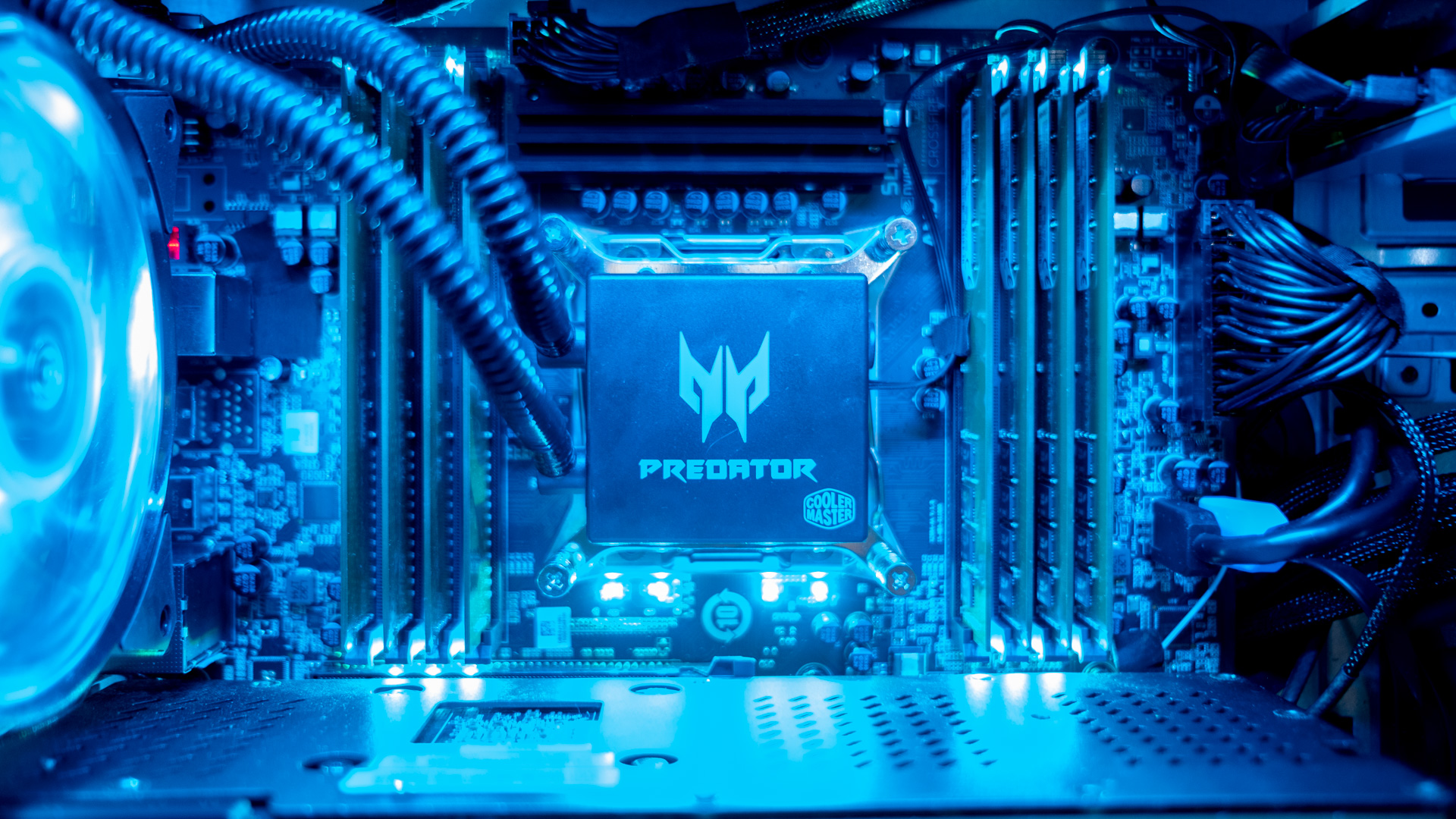

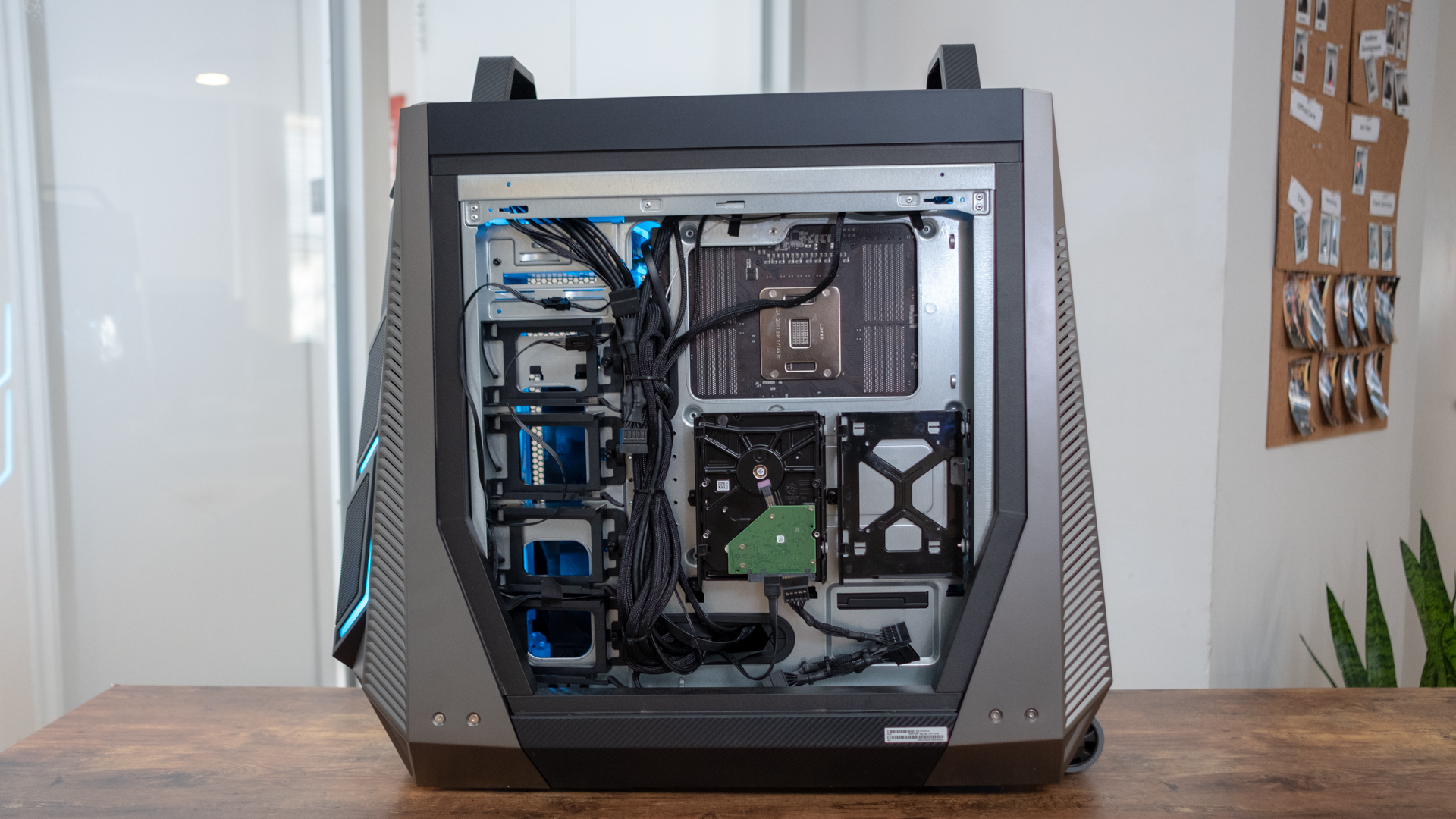
Upgradability
Opening up the Orion 9000 also reveals an interior chassis that’s surprisingly smaller than it looks from the outside. In fact, the amount of available internal volume is closer to that of a mid-tower than the full-size tower it resembles from the outside, due to a large plastic fairing that measures nearly six-inches wide around the bottom.
Despite all the external padding though, there’s plenty of hardware packed into this PC and room for even more of it. Our highest-end system already came packed to the gills with two graphics cards and all eight memory slots already filled, but we could see ourselves easily adding another GPU and more RAM to a lower-tier system.
Around the other side of the motherboard tray, there’s room for up to two hard drives and four SSDs – all of which can be mounted onto tool-less drive trays. Unfortunately, you’ll still need a screwdriver to get to the graphics cards, but this is a part you’ll likely only change out a few times.
While we’ll commend Acer for the Orion 9000’s clean interior and excellent cable management, we’re not thrilled that the interior of the chassis features unpainted, bare metal at this extreme price point.

Here’s how the Acer Predator Orion 9000 performed in our suite of benchmark tests:
3DMark: Sky Diver: 65,886; Fire Strike: 30,059; Time Spy: 15,160
Cinebench CPU: 3,332 points; Graphics: 167 fps
GeekBench: 4,971 (single-core); 40,699 (multi-core)
PCMark 8 (Home Test): 4,083 points
Total War: Warhammer II (1080p, Ultra): 71 fps; (1080p, Low): 166 fps
Middle-Earth: Shadow of War (1080p, Ultra): 138 fps; (1080p, Low): 174 fps
Performance
It would be a crime for this extremely expensive gaming desktop not to deliver the best performance we’ve ever seen. Thankfully, the Predator Orion 9000 fully delivers.
With its octodeca-core Intel Core i9-7980XE CPU, the Acer Predator Orion 9000 absolutely destroys ever single processor-intensive benchmark.
We’ve never seen higher Cinebench and Geekbench scores, and that includes the AMD Ryzen Threadripper 1950X-powered Alienware Area 51, which managed to score 2,994 and 30,434 points in single and multi-core tests, respectively. Comparatively, the Origin Millennium and its more pedestrian hexa-core Intel Core i7-8700K processor racked up 1,526 points in Cinebench and 24,978 points in Geekbench.
Those dual Nvidia GTX 1080 Ti’s also come in mighty handy for tackling the most demanding graphics benchmarks and games. As we expected, the Orion 9000’s high core-count processor opens up a bottleneck we saw in the Origin Millennium for higher frames per second in Shadow of War and improved overall 3DMark scores.

Interestingly, though, Warhammer II actually causes the Acer’s gaming desktop to falter a little with lower frames per second. If anything the XE-series CPU in the Orion 9000 should the game run even smoother by powering a greater number of AI units. This could be due to the game not being optimized for the Intel Core i9-7980XE or the fact that the processor runs at a slower clock speed than mainstream Coffee Lake processors.
Outside of benchmarks and tests, we took to playing several rounds of Overwatch at a solid 70 frames per second (fps) with the game running at 4K with all the graphical options maxed out. We also cautiously roamed the halls of Talos 1 in Prey at similarly maxed out 4K setting for a smooth 90-110 fps experience.
Honestly, though, were a bit disappointed that the frame rates weren’t higher. We were even more despondent upon realizing that even this eight-grand gaming PC still isn’t enough machine to drive a 4K, 144Hz Nvidia G-Sync HDR gaming monitor, like the Asus ROG Swift PG27UQ, at full tilt.
The only more infuriating thing about the Acer Predator Orion 9000 is it still comes with a boat load of preinstalled applications, like Norton Anti-Virus, Shop Ebates and Candy Crush Soda Saga despite its massive price tag. We feel as if Acer could have spent at least a little more on an bloatware-free version of Windows 10, considering the high-profile aspect of this machine.

Final verdict
It almost goes without saying that you probably can’t buy this gaming PC simply because so few of us will have the expendable income to afford it – ourselves definitely included. As for the ‘should you buy it’ factor, you really should think about whether you’re just going to be gaming with this PC or doing other tasks, like streaming and rendering video, at the same time.
An 18-core processor is overkill for purely PC gaming or any single task. Having two of the top-end graphics cards in the world is a slightly more reasonable purchase, especially if you plan to play on a high-frame rate or Ultra HD display.
And so for the extremely small subset of streaming/entertainment gamers that will need a gaming PC as powerful as this, you won’t be disappointed with the overbearing amount of performance you’ll get out of this machine. The desktop pads out its overt size is a little, and there are a few things we wish were better about its tool-less design, but what you have here is one fantastically well put together and configured pre-built machine ready to take on whatever the gaming world dishes.
Kevin Lee was a former computing reporter at TechRadar. Kevin is now the SEO Updates Editor at IGN based in New York. He handles all of the best of tech buying guides while also dipping his hand in the entertainment and games evergreen content. Kevin has over eight years of experience in the tech and games publications with previous bylines at Polygon, PC World, and more. Outside of work, Kevin is major movie buff of cult and bad films. He also regularly plays flight & space sim and racing games. IRL he's a fan of archery, axe throwing, and board games.
